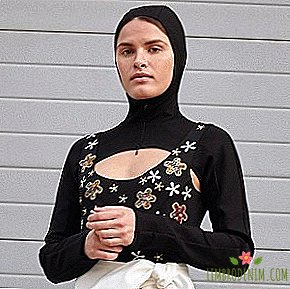Women and Sneakers: A Revolution in Masculine Culture
In mid-July in the Brooklyn Museum the exhibition "Out of Frame: Lifting Snicker Culture", almost entirely dedicated to men's shoes, opened. In the April issue of New York Magazine, exhibition curator Elizabeth Semmelhak explains her interest in the connection between sneakers and masculinity. As the senior curator of the Museum of Bata shoes in Toronto, Semmelhak knows perfectly well what he is talking about, although knowledge of sniker culture is usually persistently considered to be a man's lot (this is especially noticeable during the men's New York fashion week). She argues that “many women are interested in the topic, but their opinion is not particularly taken into account for a number of reasons - starting with the lack of sneakers in women's sizes and the prevailing masculine atmosphere around street fashion. eternal debates about femininity when it comes to female athletes. " At the same time, Semmelkhak does not deny the fact of the existence of women among collectors of sneakers, but speaks primarily about the tradition of sexism in sports, in the position of sports brands and stores, and, as a result, in the whole sniker culture.

According to her, initially sneakers were developed for both men and women, especially thanks to tennis, which became fashionable in the middle of the XIX century: comfortable shoes were needed for this thoroughbred kind of active leisure. But with the rise of basketball, it was the male stars that came to the fore: Karim Abdul-Jabbar, Walt Fraser, Michael Jordan. Sales of sneakers began to build on the images of these incredibly talented athletes and their admiration for their inaccessible results, and sports brands began to actively play this card. “Basketball is, of course, a team sport, but in every great player there is an individuality and a unique style of play, an image that sets him apart from the crowd,” says Semmelhak. Although women's sneakers make up only 10% of this market, Semmelhak calls the sneakerhead movement "the link between yard sports, urban culture, basketball, masculine identity, uncompromising personality and fashion."
On the wall of the museum hangs a huge portrait of Michael Jordan: the role of the basketball icon in the sneaker culture cannot be denied, the model of the same name with sneakers. Other striking exhibits include Louboutin gold slip-on shoes adorned with spikes that would be worn at shows in Mad Max's dystopic universe. The exposition also includes the circled 1989 documentary "Voguing: The Message" (the abstract describes vogging as an "athletic and competitive dance style that originated in New York among financially bankrupt youth as one of the ways of self-realization and demonstration of their group identity") . There is also a masculine perspective here: “Despite the fact that female vogers and those who performed in a female form, as a rule, did not wear sneakers, participants of the wagging competitions in categories based on the demonstration of a male heterosexual entity, often performed in sneakers for authenticity of the image. For the umpteenth time, sneakers played a decisive role in constructing the concept of masculinity. "

The label on the exhibition, entitled "Women and the Sniker Culture", analyzes the question like this: "Women's interest in this topic is mainly limited to shoes that refer to sneakers, but in fact they are not - like, for example, wedge sneakers. This is just one a segment in the boundless and diverse ocean of women's shoes, rooted in the 1920s, it plays into women's interest in sneakers, but doesn’t allow women to play in this field to the full. " Alas, we see the annoying confirmation of this thesis all around. Just look at the name of a large American network of sports shoes - Lady Foot Locker, because women need only lady shoes for their lady legs.
However, although many sports brands and retailers do not listen to the voice of the sneakerhead girls, their voice is clearly heard in the community of sneakers. For example, the popular blog about sneakers Kicks On Fire recently launched the #ChicksOnFire campaign on social networks. Her goal is to talk about female sneaker culture, collectors of sneakers and help them come together. This does not just help consolidate the status of the phenomenon and make it more attractive: posts on Instagram and Twitter with this hashtag make the whole female sneaker movement visible (though from time to time the hashtag is trying to discredit pornotrolli).

Heterosexual porn has made a huge contribution to the formation of the cult of high heels and their perception as synonymous with femininity.

At the same time, the exhibition has a talking photo of Hank Willis Thomas "Get up on that leg" - a portrait of a woman kissing a sock running shoe. The red lipstick on her lips matches the color of the sole and the details of the shoe. There is a definite connection between the right to dispose of one’s own sexuality and the obstacles in the path of women to the sniker culture: women’s sexuality is mainly used by men to sell goods to a male audience. When I ask Semmelhak a question about the erotic implication of the snicker culture, she has something to say.
"I also study the history of heels as part of my scientific work. He made a huge contribution to the formation of the cult of high heels and their perception as a synonym for femininity," she explains. "Even when high heels went out of women's fashion, they still did not give up their positions in male-oriented erotic films, but women in sneakers are beginning to appear gradually in porn films. In my opinion, the penetration of sneakers into the world of porn can speak about changes in the perception of beauty, but these changes I cannot be assessed positively positively, because they still remain tied to objectification. We are just witnessing the emergence of a new standard for female sexuality. " So what is the result of erotic advertising campaigns sneakers? To the next round of objectification of women? Or is there an attempt to integrate women into the sneaker community and call for them to use their sexuality and sense of style to form that “uncompromising individuality”?

On the other tablet at the exhibition are the words of Caitlin Cervini, an assistant to the fashion department of Details magazine: “Sneakers have long been an important trend in men's fashion, but gradually also became a key segment of the market for women's goods - starting mostly with the classic model Stan Smith. As a woman working in the men's fashion industry, I see sneakers thus becoming a bridge across the chasm between men's and women's clothing. Sneakers have become part of my daily look, in a sense, a uniform. "
The disappearance of the “abyss”, which Chervini speaks of, testifies first of all to the fact that the very concepts of masculinity and femininity have become more flexible. Many women solve the problem of insufficient assortment of women's sneakers by buying men's shoes: even if the model is named after a man, her audience is unisexual. Missy Elliott's "Lose Control" video spins on the screen next to the show of Vicious Rick Owens collection, where step dancers perform in adidas. At the exhibition I see both men and women - only annotations to it, signs, advertising and press releases speak about discrimination. The rise of the female snicker movement and the emergence of super sportswomen is already happening - here and now. But the struggle is still ongoing - on the territory of the language, concepts and definitions.
The "male-centered" exhibition, in fact, perfectly demonstrates the problem that needs to be solved, and this is its big plus, even if its creators did not plan to undertake such a mission. It remains for us to eradicate the condescending attitude towards women, which constantly slips into speech. This is a war against domestic sexism, which is long overdue for a landfill. There are millions of women in the world wearing sneakers, many of them collect, each has its own story. We talked with three enthusiasts of the sneaker movement, each of which is unique.


Nandi Loaf - a Brooklyn artist and a graduate of the art college Cooper Union - perceives sneakers and clothing in general as one of the ways of self-expression. She appears on our doorstep in a vintage sky-blue Gucci jumpsuit, which she cuts like shorts, with a sponge-bob necklace. “My image is as complete and open to interpretation as the painting on the wall,” she says. The pride of her collection is the classic white Nike Air Force 1, which she painted with pastel pink acrylic paint, and another pair she found - with Sponge Bob, painted with a marker. When she is in them, she is constantly stopped on the street and asked where she took them. For Nandi, this is not a matter of brand loyalty, but rather the fact that they are “burning”.
As a child, she was dragged along the “Jordans” who decorated the legs of passersby: “Mom refused to buy them until I was twelve - then my leg had to stop growing. But even up to this point I always treated sneakers as part of my collection, I remember that I even put them on the shelves instead of books. I come from New York. Sniker culture plays an important role here, especially in the upper grades. What is on your feet is a kind of social certificate. " Her words are confirmed by one more abstract at the "Rise of Sneaker Culture" exhibition. April Walker, founder of the streetwear brand Walker Wear, recalls her childhood: “As a child, living in the heart of Brooklyn, I learned early on that sneakers are not just shoes. It was a status symbol associated with the level of toughness ... was not a teenager. "


A native of the East Village, Anna Sian, when she was a teenager, played basketball and touch rugby in the schoolyard and dressed in clothes with a teenager, and she always appreciated comfort in the first place. She admits that it was not always easy to grow with a tombo - in her own way she was looking for a balance between assertiveness and grace, but she eventually found her way. She has a lot of sneakers, from bright “Jordans” for playing basketball to more neutral ones for each day: “I love everyday black and white jogging shoes that can be worn around the clock.” When asked which model was decisive for her, she replies that it all started with the Nike Blazer. For her, as for the musician and the artist, the style is an expression of her inner world and gushing creativity.
Number one on her list is a pair of white conversions, which obviously will not soon come out of her daily life. She jokes that "she does not plan to spend money on a new pair until she puts this into holes." The question of sexist methods for selling sneakers doesn’t surprise her a bit: “Men have always dominated the sneaker culture, this is not news. I can’t talk with confidence about all the сексу sex’ advertising campaigns, but most of them use double standards on the edge Misinformation and support for women. I prefer to advertise fashion shots in which there is more depth and context. "


Nadia Kaanan, in turn, now lives between two cities - she is in the process of moving from New York to Berlin. Unlike the other two heroines, she grew up in Saudi Arabia, where her "only window to the Western world were music videos, video rentals, books and oatmeal packaging." She also grew up as an active teenager: she played volleyball, basketball, and in high school was the president of the class. The obsession with white sneakers eventually led her to work in the fashion industry, or rather, with the sneakers themselves. She is a PR specialist and trend analyst at adidas: it is her team that is responsible for luxury collaborations with designers like Rick Owens or Yoji Yamamoto, who glorified the company outside its traditional audience. At the same time, she does not give up an active lifestyle - DJ, plays basketball, rides a bicycle. "I am an active person by nature, comfort is important to me and the combination of these two factors determines what I wear."
Nadia believes that accepting one's own sexuality does not contradict the sneaker culture: “Sexually confident women with a clear position is a step in the right direction. I mean not the Instagram stars, whose image is 97% ass, and only 3% sneakers. But in general, there is nothing wrong with women taking their sexuality in their hands. " Nadia calls the shoe of her dreams the current adidas collaboration with Raf Simons - sneakers on an openwork platform. Such shoes are pleasing, and this joy is based on sexuality, sport, art and faith in yourself.




